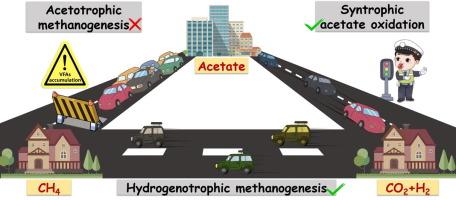当前位置:
X-MOL 学术
›
Chem. Eng. J.
›
论文详情
Our official English website, www.x-mol.net, welcomes your
feedback! (Note: you will need to create a separate account there.)
Strengthening the syntrophic pathway for acetate oxidation-hydrogenotrophic methanogenesis by biogas stirring for effectively mitigating acidification in anaerobic digestion
Chemical Engineering Journal ( IF 13.3 ) Pub Date : 2024-11-19 , DOI: 10.1016/j.cej.2024.157834 Yi Han, Si Yang, Gang Guo, Jing Chen, Xiaohui Wu, Feixiang Zan
Chemical Engineering Journal ( IF 13.3 ) Pub Date : 2024-11-19 , DOI: 10.1016/j.cej.2024.157834 Yi Han, Si Yang, Gang Guo, Jing Chen, Xiaohui Wu, Feixiang Zan

|
Anaerobic digestion (AD) frequently encounters challenges such as acidification under high organic loadings, leading to system instability or failure. This study demonstrates that biogas stirring (RB) effectively mitigates acidification during the AD of FW (FW), outperforming traditional mechanical stirring (RM). The RB system sustained stable methane production, reaching 249.1 mL CH4/g VSadded/d, whereas the RM system encountered significant acidification, with a pH dropping to 5.0 ± 0.2, impeding methanogenesis. For sludge characteristics, biogas stirring in the RB system significantly decreased particle size to 78 μm, which were anticipated to facilitate mass transfer and substrate conversion. Focus on the microbial communities evolution, employing biogas stirring facilitated a rational microbial collaboration with the enhanced capability for volatile fatty acids (VFAs) conversion and methane production. In addition, Methanobacterium, a typical methanogen for hydrogenotrophic methanogenesis (HM), was predominant in RB, occupying in an important position (Centrality = 0.9232) in the microbial network. Furthermore, the increased H2 partial pressure enriched the concentration of F420 by 63.1 %, facilitating its uptake and supporting the growth syntrophic acetate-oxidizing (SAO) bacteria. The consequent activation of the SAO-HM pathway is key to rapidly restoring methane production post-acidification. The findings of this study revealed the underlying role of biogas stirring for SAO-HM pathway and provided a potential strategy to facilitate acidification alleviation in AD.
中文翻译:

通过沼气搅拌加强乙酸盐氧化-氢营养甲烷生成的共养途径,以有效缓解厌氧消化中的酸化
厌氧消化 (AD) 经常遇到挑战,例如在高有机负载量下酸化,从而导致系统不稳定或故障。这项研究表明,沼气搅拌 (RB) 有效减轻了 FW (FW) AD 期间的酸化,优于传统的机械搅拌 (RM)。RB 系统维持稳定的甲烷产生,达到 249.1 mL CH4/g VS添加/d,而 RM 系统遇到明显的酸化,pH 值降至 5.0 ± 0.2,阻碍了甲烷生成。对于污泥特性,RB 系统中的沼气搅拌将粒径显著降低至 78 μm,预计这将促进传质和底物转化。专注于微生物群落的进化,采用沼气搅拌促进了合理的微生物合作,增强了挥发性脂肪酸 (VFA) 转化和甲烷生产的能力。此外,甲烷杆菌是氢营养型甲烷生成 (HM) 的典型产甲烷菌,在 RB 中占主导地位,在微生物网络中占据重要位置 (中心性 = 0.9232)。此外,增加的 H2 分压使 F420 的浓度富集了 63.1%,促进了其吸收并支持共养乙酸氧化 (SAO) 细菌的生长。SAO-HM 通路的后续激活是酸化后快速恢复甲烷生成的关键。本研究的结果揭示了沼气搅拌对 SAO-HM 途径的潜在作用,并为促进 AD 中的酸化缓解提供了一种潜在的策略。
更新日期:2024-11-20
中文翻译:

通过沼气搅拌加强乙酸盐氧化-氢营养甲烷生成的共养途径,以有效缓解厌氧消化中的酸化
厌氧消化 (AD) 经常遇到挑战,例如在高有机负载量下酸化,从而导致系统不稳定或故障。这项研究表明,沼气搅拌 (RB) 有效减轻了 FW (FW) AD 期间的酸化,优于传统的机械搅拌 (RM)。RB 系统维持稳定的甲烷产生,达到 249.1 mL CH4/g VS添加/d,而 RM 系统遇到明显的酸化,pH 值降至 5.0 ± 0.2,阻碍了甲烷生成。对于污泥特性,RB 系统中的沼气搅拌将粒径显著降低至 78 μm,预计这将促进传质和底物转化。专注于微生物群落的进化,采用沼气搅拌促进了合理的微生物合作,增强了挥发性脂肪酸 (VFA) 转化和甲烷生产的能力。此外,甲烷杆菌是氢营养型甲烷生成 (HM) 的典型产甲烷菌,在 RB 中占主导地位,在微生物网络中占据重要位置 (中心性 = 0.9232)。此外,增加的 H2 分压使 F420 的浓度富集了 63.1%,促进了其吸收并支持共养乙酸氧化 (SAO) 细菌的生长。SAO-HM 通路的后续激活是酸化后快速恢复甲烷生成的关键。本研究的结果揭示了沼气搅拌对 SAO-HM 途径的潜在作用,并为促进 AD 中的酸化缓解提供了一种潜在的策略。


















































 京公网安备 11010802027423号
京公网安备 11010802027423号